Charts of the Week
Charts of the week from 13 to 17 May 2024: gross domestic product, value of fiscally verified invoices, electricity consumption by consumption group and other charts
In the first quarter of this year, year-on-year economic growth (2.1%) was similar to that recorded in the fourth quarter of last year, supported by private and government consumption. Investment activity, which experienced significant growth last year, has weakened, total exports remained negative year-on-year and goods exports exceeded last year’s level. Growth in the nominal value of fiscally verified invoices, which was around 4% last month, suggests that year-on-year growth of private consumption continued into the second quarter. In the first quarter, the year-on-year growth in the number of persons in employment (around 1.4%) was higher than in the final months of last year due to a methodological change. This continued to be driven by a higher number of foreigners in employment, particularly in construction, transportation and storage, and administrative and support service activities. The current account surplus further increased year-on-year in the first quarter, mainly due to the goods balance. With more working days this April, the year-on-year decline of electricity consumption in the distribution network was slightly lower than in previous few months.
Gross domestic product, Q1 2024
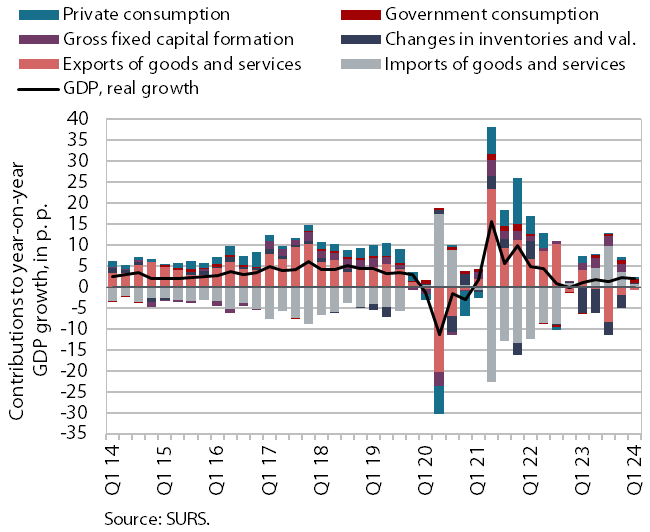
GDP stagnated in the first quarter of this year, while it was 2.1% higher year-on-year (not seasonally adjusted). Household consumption rose by 0.9% year-on-year, with households spending more on tourist services abroad, cars and food and less on non-food products and overnight stays in Slovenia. The growth in government consumption increased further (by 5.1% year-on-year), mainly in relation to the transformation of supplementary health insurance into a mandatory contribution (now a public source of funding). Investment activity, following a period of high growth in the previous year, has weakened (0.6% year-on-year), along with growth in value added in construction. After a strong negative contribution last year, inventories made a positive contribution (0.1 p.p.) to the growth in gross investment this time. Exports of goods and value added in manufacturing increased for the second consecutive quarter and were also higher year-on-year. Total exports of goods and services fell by 0.6% due to a decline in exports of services and total imports fell by 0.9%, which had a positive impact on GDP growth as the contribution of the foreign trade balance was 0.2 p.p.
Value of fiscally verified invoices, in nominal terms, 28 April–11 May 2024
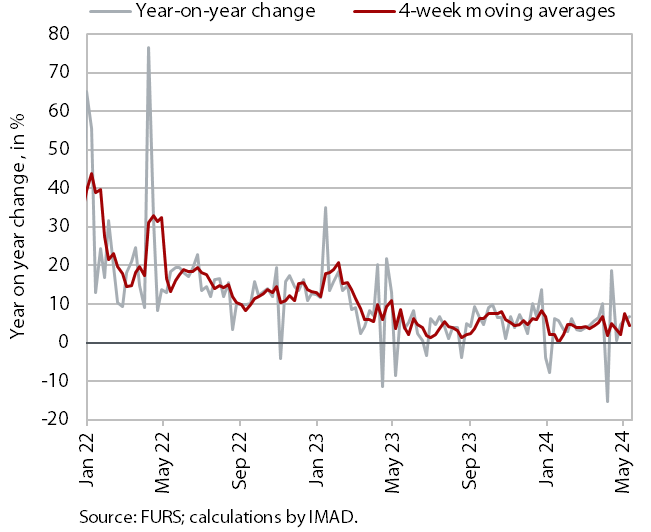
The nominal value of fiscally verified invoices between 28 April and 11 May was 7% higher year-on-year. The different timing of the Easter and Labour Day holidays this year compared to last year has influenced the year-on-year fluctuations in the last few 14-day periods. The average growth over the last two periods was around 4%, which is in line with the average for all periods so far this year. Over the last two periods, the average year-on-year growth of turnover in retail trade (4%), which accounts for almost 80% of the total value of fiscally verified invoices, has also remained similar to the average for all previous periods of the year. Turnover growth in retail trade and the sale of motor vehicles was around 5%, while it remained down year-on-year in wholesale trade. Total year-on-year turnover in accommodation and food service activities and in certain creative, arts, entertainment, and sports services and betting and gambling remained high, averaging 10% in the last two periods.
Electricity consumption by consumption group, April 2024
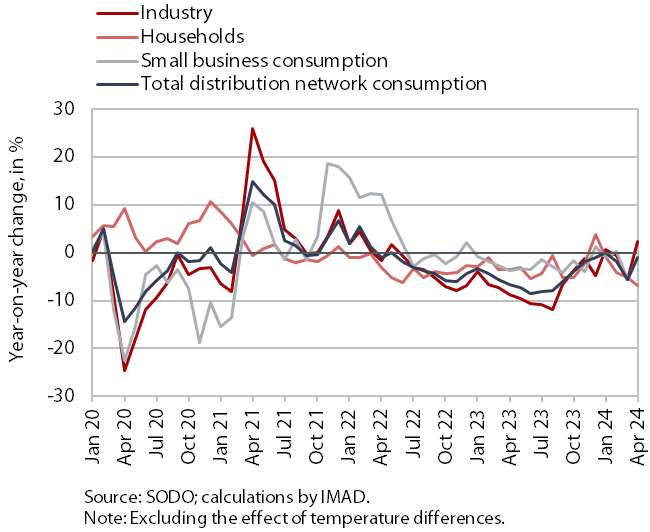
In April, the year-on-year decline of electricity consumption in the distribution network was slightly lower partly due to more working days. With three more working days this April, industrial consumption was 2.3% higher year-on-year, while small business consumption was slightly lower (by 0.9%). Household electricity consumption in April was 6.9% lower year-on-year, partly attributable to frequent power outages due to maintenance works and snowfall.
Activity in construction, March 2024
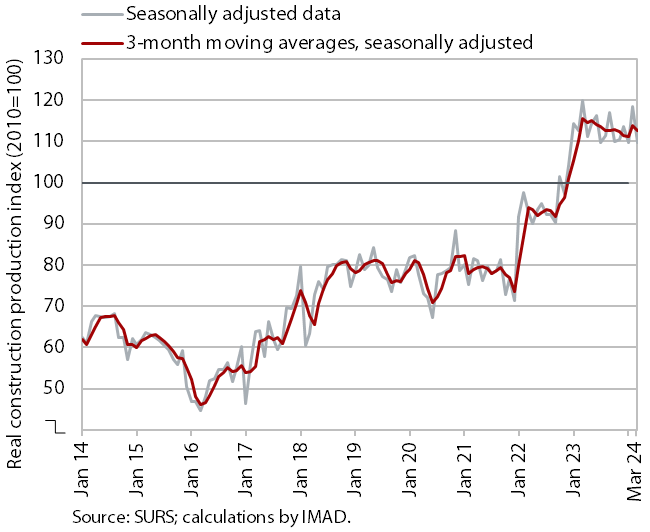
According to data on the value of construction work put in place, construction activity fell in March and was also down year-on-year. After high growth at the beginning of last year, activity declined gradually amid monthly fluctuations. In the first quarter, it was 3% lower than in the first quarter of last year. The sharpest decline in activity was recorded in building construction (7%).
Some other data, however, point to growth in construction activity. According to VAT data, the activity of construction companies in the first quarter was 8% higher than the same period last year. When compared to the data on the value of construction put in place, this represents a notable difference of 11 p.p. in the growth of this activity.
Current account of the balance of payments, March 2024
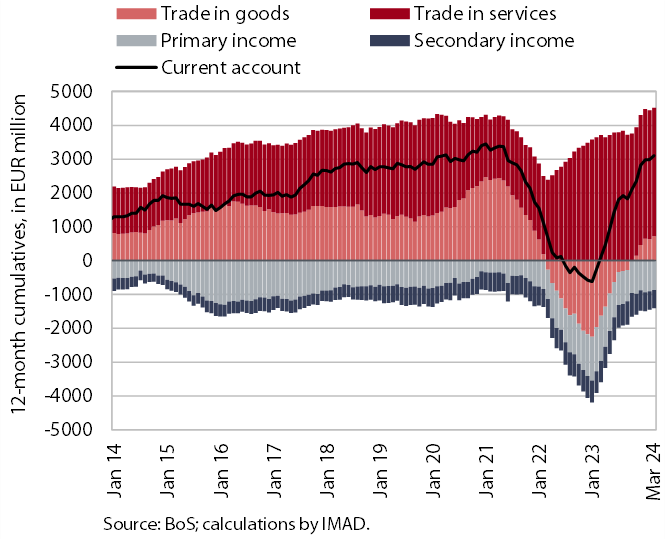
In the first quarter of this year, the current account surplus widened year-on-year. This was mainly due to the goods trade balance. Real exports of goods increased year-on-year, while imports fell, and the terms of trade improved due to a further decline in energy and industrial producer prices. We estimate that volume and price movements contributed similarly to the year-on-year change in the nominal goods trade balance (EUR 261 million) in the first quarter. The surplus in trade in services was lower year-on-year mainly due to a lower surplus in trade in transport services. The primary income deficit was similar to that in the same period last year. The lower secondary income deficit resulted mainly from lower net outflows of general government transfers to the rest of the world. The 12-month balance of the current account of the balance of payments showed a surplus of EUR 3.1 billion in March (4.6% of estimated GDP).
Number of persons in employment, March 2024
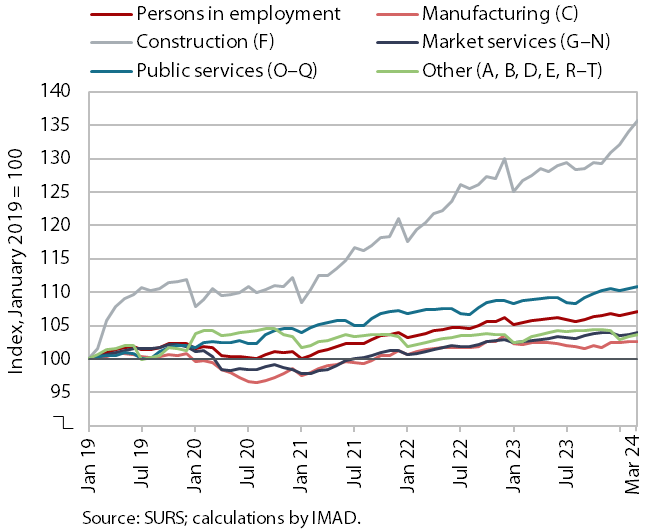
The number of persons in employment continued to rise year-on-year in March. Growth was similar (1.4%) to the first two months of this year and higher than in the final months of 2023. The acceleration was mainly due to a change in the definition of persons in employment, which now includes also workers posted abroad. Growth was the highest in construction, which faces great labour shortages, and the increase was further boosted by the aforementioned change in the definition of the labour force. The year-on-year increase in the total number of persons in employment was due to a higher number of employed foreign nationals, while the number of employed Slovenian citizens fell. The share of foreign citizens among all persons in employment was 15.6% in March, 1.4 p.p. higher than a year earlier. Notably, the activities with the largest shares of foreign workers were construction (50%), transportation and storage (33%) and administrative and support service activities (29%).
